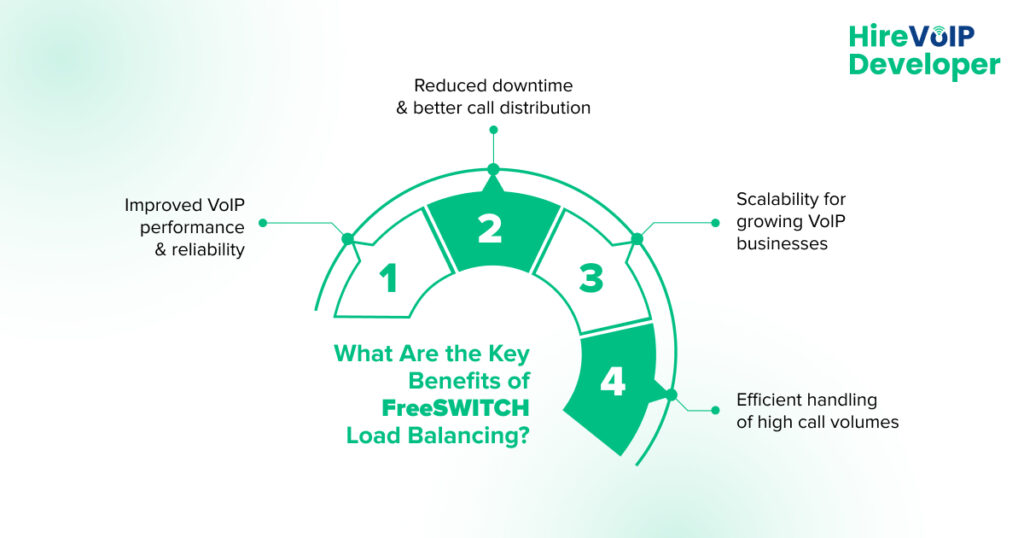📝 Blog Summary
Find out how FreeSWITCH load balancing transforms VoIP performance by distributing traffic, preventing overloads, and enabling seamless scalability. This guide covers setup steps, best practices, performance tips, and security insights, perfect for businesses aiming to optimize their VoIP infrastructure. Dive in to explore FreeSWITCH’s full potential!
Since VoIP technology was introduced in business communication, it has changed how we communicate with customers, allowing us to do so more efficiently and with fewer resources. VoIP has successfully replaced the traditional telephony system while eliminating the hardware cost and monthly recurring fees. VoIP utilizes the Internet for calls, significantly reducing phone bills, especially for long-distance and international calls.
But like every great technology, even the most powerful VoIP systems aren’t ready for the occasional disasters, such as uneven call traffic, server loads, or latency issues. Therefore, load balancing is critical for VoIP systems to ensure consistent performance. You can use Freeswitch to set up load balancing for your VoIP platform and configure a FreeSWITCH server to act as the outbound call line handler. So, how do you set up load balancing using FreeSWITCH for your VoIP system?
In this blog, you will get an overview of FreeSWITCH for load balancing, its benefits, best practices, some common challenges in load balancing setup, and, most importantly, how to set up load balancing for your VoIP using FreeSWITCH.
What is FreeSWITCH Load Balancing?
Freeswitch load balancing is a technique for optimizing the performance of the VoIP network using an open-source telephony technology called Freeswitch. It distributes incoming SIP ( Session Initiation Protocol) traffic and call processing workload across multiple servers. This technique helps to prevent any single server from becoming overloaded.
You can imagine this as if you own a restaurant, and today, there is a high rush of customers at your restaurant. Now, they all crowd at one table, making the environment congested. So, someone from the staff will help customers find a table and distribute the overall crowd across all available tables at your restaurant. The person here is acting as a load balancer, which is done using FreeSwitch.
The purpose of Freeswitch load balancing is to distribute the load on servers. At the same time, you achieve maximum resource utilization and minimize the risk of service interruption due to any overload or server failure.
💡 Did You Know?
Load Balancing Reduces Downtime by Over 80% in VoIP Systems. By automatically rerouting traffic away from failed FreeSWITCH servers, load balancing prevents call drops and outages.
What Are the Key Benefits of FreeSWITCH Load Balancing?

1. Improved VoIP performance and reliability
Load balancing distributes SIP signaling and RTP (Real-time Transport Protocol) media streams across multiple FreeSWITCH instances. This distribution mitigates single points of failure, ensuring that if one instance becomes unavailable, others can continue processing calls.
Furthermore, by distributing the computational load associated with call processing (e.g., transcoding, media mixing), load balancing reduces latency and jitter, improving call quality. The distribution also minimizes resource contention, leading to a more predictable call flow.
These optimizations are often driven by developer-level improvements. See how FreeSWITCH developers improve VoIP to support more scalable systems.
2. Reduced Downtime and Better Call Distribution
A load balancer acts as a SIP proxy, inspecting incoming SIP requests and directing them to available FreeSWITCH servers based on predefined algorithms (e.g., round-robin, least connections, load-based). Solutions like Kamailio SIP Proxy are often used in such scenarios to manage SIP signaling efficiently. This redundancy significantly reduces downtime, as the load balancer can automatically redirect traffic away from failed or overloaded servers.
The load balancer can also perform health checks on FreeSWITCH instances, removing unhealthy servers from the pool. This intelligent call distribution ensures optimal resource utilization and minimizes the impact of server failures on call quality.
Why wait for your system to crash? Prevent it with our load balancer.
3. Scalability for Growing VoIP Businesses
Load balancing enables horizontal scaling, allowing you to add more FreeSWITCH servers to handle increasing call volumes. The load balancer abstracts the complexity of managing multiple servers, presenting a single entry point for SIP traffic.
This simplifies network configuration and management, making it easier to scale your VoIP infrastructure. The load balancer can also employ dynamic scaling techniques, automatically adjusting the number of active servers based on real-time traffic patterns.
4. Efficient Handling of High Call Volumes
By distributing call processing workloads across multiple servers, load balancing prevents any single server from becoming a challenge. This is particularly important during peak call volumes, when a single server may struggle to handle the load. Load balancing ensures calls are processed efficiently, minimizing latency and preventing call drops.
Also, by distributing the workload, the CPU and memory of the FreeSWITCH servers are used more evenly, allowing for a higher number of concurrent calls.
How do you set up a FreeSWITCH Load Balancer for VoIP?
This section may be overwhelming because it is more of a technical side, but don’t worry. We will understand the complete setup in 2 major parts: 1) foundation, and 2) steps involved.
1) Laying the Foundation
A. Robust FreeSWITCH Server Infrastructure:
You’ll need multiple FreeSWITCH instances, each with its own dedicated resources (CPU, RAM, network bandwidth). These servers should be configured consistently, ensuring uniform capabilities for call processing. Ensure each FreeSWITCH server has a static, routable IP address and a well-defined SIP profile.
B. Dedicated Load Balancer Server with SIP Proxy Software:
A dedicated server, separate from the FreeSWITCH instances, is crucial. This server will host the SIP proxy software (Opensips or Kamailio), which acts as the central traffic director. The load balancer server should have ample network bandwidth and processing power to handle the anticipated call volume.
C. Network Topology and Connectivity:
A strong and fast network is essential for good performance. Every server, including FreeSWITCH and the load balancer, must have reliable connectivity to allow smooth communication. It’s also necessary to set up clear network areas and specific firewall rules to protect the VoIP network from threats. This helps create a safe space for all communications.
D. SIP and FreeSWITCH Configuration Expertise:
Understanding the Session Initiation Protocol (SIP) is very important. Knowing how to configure FreeSWITCH files to improve communication systems is also essential. Knowing about load balancing helps manage traffic smoothly. Additionally, being familiar with the configuration language of SIP proxy software is necessary to create solutions that fit specific needs.
2) Building the Structure
A. Deployment and Configuration of the SIP Proxy:
Install your chosen SIP proxy software (Opensips or Kamailio) on the dedicated load balancer server. Define routing logic that dictates how SIP requests should be distributed. For example, round-robin is used for equal traffic sharing or the least connections for load-aware distribution. Configure the SIP proxy to listen on standard ports (like 5060 UDP/TCP) and apply security hardening such as TLS support and IP safelisting.
B. FreeSWITCH Server Registration:
Each FreeSWITCH instance should be configured to register as a SIP endpoint with the proxy. This involves setting the proxy as the registrar and outbound proxy within the FreeSWITCH SIP profile configuration. Additionally, you can enable periodic keep-alive or OPTIONS pings from FreeSWITCH to let the proxy know it’s online. This registration process is vital for dynamic routing and accurate health monitoring.
C. Load Balancing Logic Implementation:
Implement your chosen algorithm inside the SIP proxy config by referencing the registered FreeSWITCH endpoints. For example, with Kamailio, you can use the dispatcher or load_balancer modules to handle call distribution. Implement real-time health checks using SIP OPTIONS to ping each server, and define logic to exclude servers that fail to respond. For more flexibility, you can add priority tiers and retry strategies in your routing logic.
D. Health Monitoring and Failover:
Continuously monitor the availability of each FreeSWITCH server via automated health checks. The SIP proxy should be configured to send periodic SIP OPTIONS messages and interpret the responses. If a server becomes unresponsive, the load balancer should dynamically remove it from the pool and reroute calls to healthy servers. This not only improves reliability but also reduces manual intervention during outages.
E. Thorough Testing and Validation:
Before going live, simulate various scenarios, including peak loads, node failures, and proxy restarts. Use tools like sngrep, Wireshark, or SIP to visualize and stress test SIP signaling. Verify that your call traffic is properly balanced and that failovers occur seamlessly. Document your testing results and ensure alerts or monitoring dashboards are in place for real-time visibility post-deployment.
Now that you know how to set up a loan balancer for VoIP, it’s time to learn how to make it more effective. In the next section, we’ll explore this further.
What Are the Best Practices for FreeSWITCH Load Balancing?
For optimal FreeSWITCH load balancing, use a combination of hardware and software load balancers and a strong failover strategy. Here’s a breakdown of best practices:
1. Use DNS SRV or Load Balancer-aware SIP Clients
Instead of just dialing one number, your phone can ask, ‘Hey, who’s available?'” Using DNS SRV records or clients that understand load balancing, your phones can pick the best FreeSWITCH server on the fly. This means if one server’s having a bad day, your calls just keep on truckin’. It’s all about making your phone adaptable!
2. Enable Health Checks
You wouldn’t want to send customers to a closed restaurant, right?” The same goes for your FreeSWITCH servers. We’ll set up health checks on your load balancer so it constantly asks, ” Are you good, FreeSWITCH server?” If a server isn’t answering, it automatically gets removed from the rotation. This keeps your calls flowing smoothly without any hiccups.
3. Use Stateful Load Balancing for Sticky Sessions
Have you ever had a long chat with someone and suddenly been switched to someone else?” Annoying, right? Some exceptionally long calls must stay on the same FreeSWITCH server. Stateful load balancing makes sure that happens. It’s like keeping the conversation going with the same person without interruptions.
4. Enable SIP Keep-Alives
Sometimes, firewalls and routers can be forgetful. They might close your SIP connections if they’re idle for too long. SIP keep-alives are like little nudges, reminding those connections that they’re still needed. This prevents dropped calls and keeps things running smoothly.
5. Balance Both Inbound and Outbound Calls
Getting caught up in incoming calls is easy, but don’t forget the ones going out. Your FreeSWITCH servers work both ways, so balance the load for both. Monitoring and balancing outbound calls is just as important as inbound calls.
Top Troubleshooting Challenges in FreeSWITCH VoIP Load Balancing
1. Load Balancing Inconsistencies
Sometimes, even if you have a good setup, calls may not be shared evenly. Some FreeSWITCH servers can get overloaded while others have little to do. This usually happens because of configuration problems.
To avoid inconsistencies, double-check your load balancer’s configuration. Make sure your routing rules are solid and your health checks are working correctly. Next, give your network a good once-over. Look for any challenges or connectivity issues that could be throwing things off. And don’t forget to check your FreeSWITCH server registrations. If they are not registering correctly, the load balancer will not send traffic to them.
2. Performance Challenges
Your VoIP system might experience performance challenges, such as dropped calls, delays, or just bad performance.
It’s time to put on your detective hat and monitor your traffic. Use tools to see where the slowdowns are happening. Then, start optimizing your settings. Things like codec selection, media handling, and database queries can all impact performance. Also, keep an eye on your server resources. You should add more resources if your CPU or memory is maxed out. Finally, if you use a database, ensure it is optimized and responds quickly.
3. Security Vulnerabilities
In today’s world, security is no joke. VoIP systems can be targets for attacks, so you need to be proactive.
Here, the firewall is your first line of defense. Make sure it’s configured to block any unwanted traffic. Then, consider adding an intrusion detection system. This will help you spot any suspicious activity. Also, keep your software up to date. Security patches are crucial for staying ahead of the bad guys. And don’t forget about strong passwords and access controls. It’s all about layering your defenses. Using TLS and SRTP for encrypted communication is also a must.
A well-executed FreeSWITCH load balancer setup is key to maintaining a scalable and high-performing VoIP system. From distributing SIP traffic intelligently across multiple servers to handling high call volumes with minimal latency, FreeSWITCH load balancing benefits modern businesses by reducing downtime, optimizing server resources, and ensuring consistent call quality.
Why wait for your system to crash? Prevent it with our load balancer.
You can significantly improve FreeSWITCH performance optimization by following best practices like health checks, sticky sessions, SIP keep-alives, and balancing both inbound and outbound traffic. Of course, challenges like routing inconsistencies, performance challenges, and security gaps can arise, but a solid strategy can minimize their impact.
If you’re wondering how to set up load balancing for VoIP or need support with your FreeSWITCH SIP load balancer configuration, our experts’ help can make all the difference. Hire a dedicated FreeSWITCH developer from Hire VoIP Developer and get expert assistance specific to your business needs.


